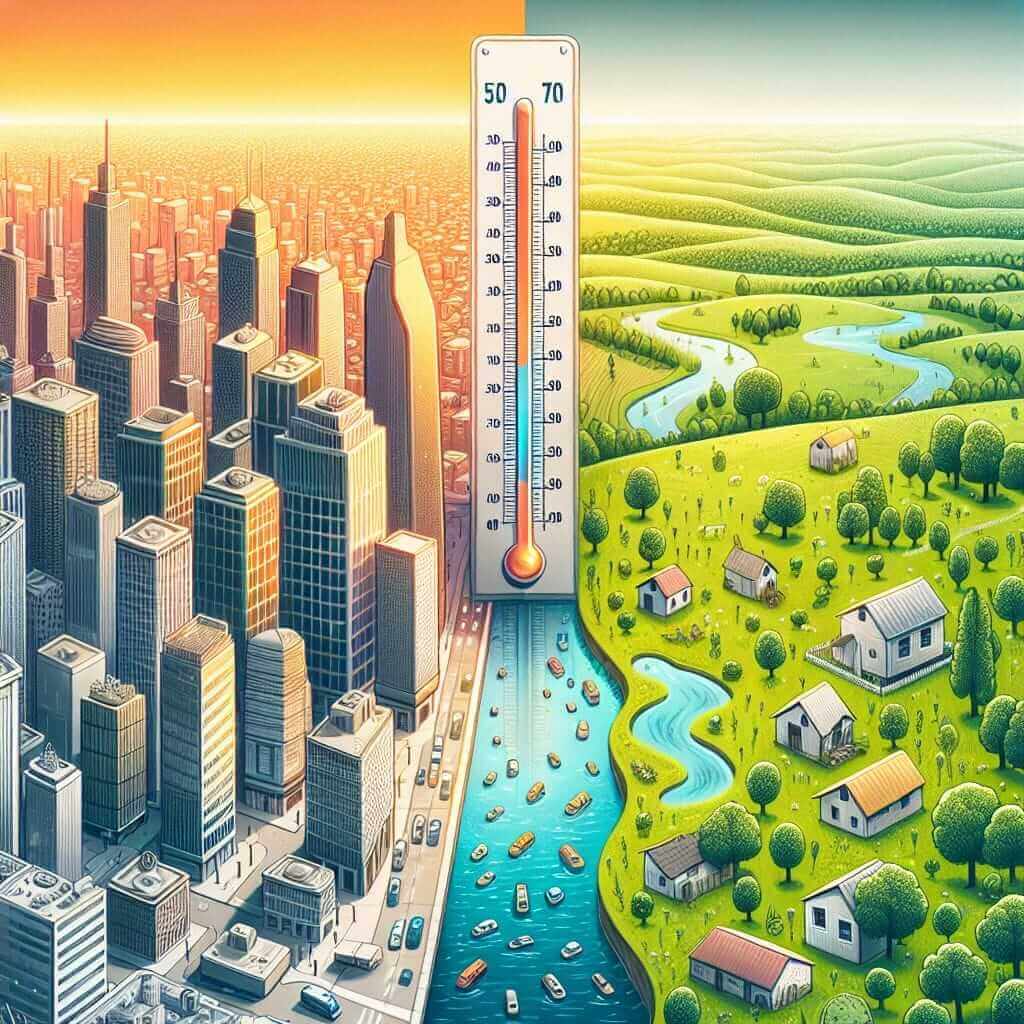Urban heat islands (UHIs) are a significant environmental phenomenon that environmentalists and urban planners have been focusing on in recent years. UHIs occur when urban areas experience higher temperatures than their rural surroundings due to human activities. This topic is increasingly appearing in IELTS essay questions, reflecting its importance and relevance in modern discourse. Understanding the effects of urban heat islands on city living not only helps in tackling the IELTS Writing Task 2 but also contributes to our broader understanding of environmental impacts and urban planning.
Based on historical analysis of IELTS essay topics, themes related to the environment and urbanization, including UHIs, have appeared frequently. Given the growing awareness of global warming and its effects, it is likely that such topics will continue to be included in future exams. Past IELTS exams reveal similar topics such as “the impact of pollution on urban living” and “the role of green spaces in cities.”
Analysis and Writing on Urban Heat Islands in IELTS Context
Selected IELTS Essay Prompt on Urban Heat Islands
Task:
Some cities are experiencing higher temperatures due to the phenomenon of urban heat islands. What are the causes and effects of this on city dwellers?
Breakdown and Analysis of the Essay Prompt
Understanding the Instruction:
- Task Type: This is a combination of a cause and effect essay.
- Main Keywords: Urban heat islands, causes, effects, city dwellers.
- Expectations: The response should clearly identify multiple causes leading to the phenomenon of UHIs and discuss various effects on the residents of urban areas.
Writing Sample
Urban Heat Islands and Their Impact on City Living
Urban heat islands (UHIs) are a modern environmental challenge where urban regions exhibit significantly higher temperatures than their rural neighbors. This phenomenon, driven by both anthropogenic and environmental factors, has extensive implications for city dwellers, affecting health, comfort, and urban infrastructure.
Causes of Urban Heat Islands:
Primarily, the causes of UHIs stem from the modifications humans make to natural environments. Urbanization involves replacing vegetation with concrete, asphalt, and buildings. These materials absorb and retain heat, leading to increased temperatures. Furthermore, the high density of buildings and population causes heat to be trapped, aggravating the heat island effect. Another contributing factor is the heat generated from vehicles, factories, and air conditioning units, known as anthropogenic heat. The lack of shading and green spaces further exacerbates this issue.
Effects on City Dwellers:
The impact of UHIs on city residents is multi-faceted. Health-wise, elevated temperatures can lead to heat-related illnesses such as heatstroke and dehydration, disproportionately affecting vulnerable populations like the elderly and children. Additionally, UHIs can deteriorate air quality, as higher temperatures accelerate the formation of ground-level ozone, a harmful pollutant. Consequently, this can exacerbate respiratory conditions like asthma.
Economically, the increased need for air conditioning during hotter months can lead to higher energy consumption, raising utility bills for residents and increasing the overall demand for electricity. This can strain the city’s power supply, leading to potential outages and increased greenhouse gas emissions.
Environmentally, UHIs contribute to the urban area’s increased energy consumption and carbon footprint, perpetuating the cycle of climate change. Socially, the discomfort and health risks posed by extreme heat can deter outdoor activities, reducing the quality of urban life and social cohesion.

In conclusion, urban heat islands are a pressing issue with diverse causes including urbanization, material infrastructure, and anthropogenic heat. The effects on city inhabitants are significant, ranging from health risks and economic costs to environmental and social impacts. Addressing UHIs requires a multifaceted approach, including increasing green spaces, improving urban planning, and promoting sustainable practices.
Word Count: 322
Key Points for Writing on This Topic
Vocabulary and Grammar:
- Urbanization (noun) – /ˌərbəniˈzāSHən/ – The process of making an area more urban.
- Anthropogenic (adjective) – /ˌanTHrəpōˈjenik/ – (chiefly of environmental pollution and pollutants) originating in human activity.
- Greenhouse Gas Emissions (phrase) – Release of gases, such as carbon dioxide and methane, that contribute to the greenhouse effect.
- Dehydration (noun) – /ˌdēˌhīˈdrāSH(ə)n/ – A harmful reduction in the amount of water in the body.
- Air Quality (noun) – The degree to which the ambient air is pollution-free, assessed by measuring a number of indicators of pollution.
Important Grammar Structures:
- Cause and Effect Structure – Utilize conjunctions such as “because,” “since,” and “therefore” to link causes and effects.
- Complex Sentences – Integrate subordinate clauses to present detailed explanations or additional information, e.g., “Another contributing factor is the heat generated from vehicles, factories, and air conditioning units, known as anthropogenic heat.”
- Passive Voice – Use to emphasize the action and its effects over the subject performing the action, e.g., “The high density of buildings and population causes heat to be trapped.”
Conclusion
Urban heat islands are an essential topic for IELTS writing, given their relevance to current global challenges. Not only do they provide ample points for discussion around causes and effects, but they also invite candidates to explore solutions and practical knowledge application. Similar thematic questions might involve environmental pollution, climate change, and sustainable urban planning, hence preparing for a broad range of interconnected topics is highly beneficial.
By understanding and practicing well-structured responses to such topics, IELTS candidates can enhance their writing skills and increase their chances of achieving higher band scores.